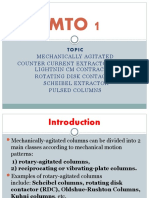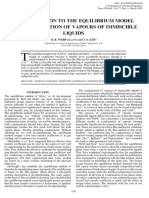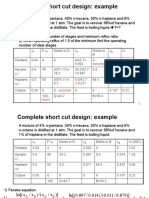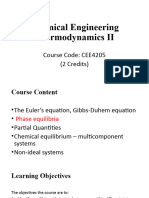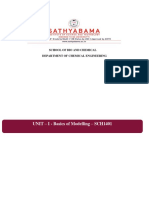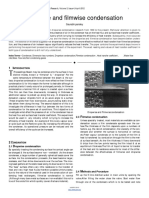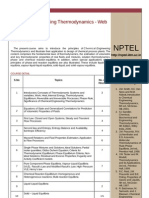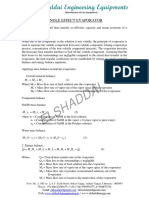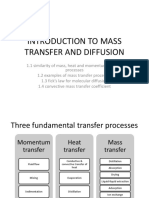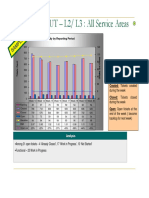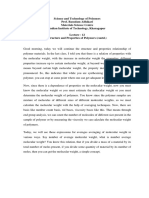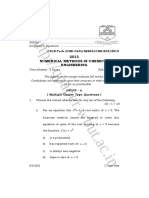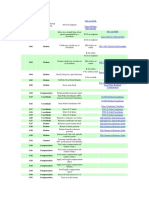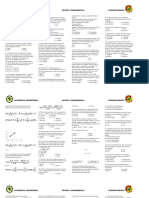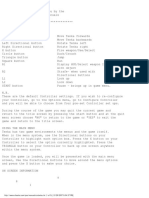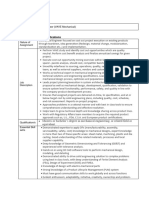Module 1 : Equation Forms in Process Modeling
Section 3 : Distributed Parameter Models and Abstract Equation Forms
3. Differential Algebraic Equations
Most of the systems encountered in chemical engineering are distributed parameter systems. Even
though behavior of some of these systems can be adequately represented by lumped parameter models,
such simplifying assumptions may fail to provide accurate picture of system behavior in many situations
and variations of variables along time and space have to be considered while modeling. This typically
results in a set of partial dierential equations (PDEs) or ordinary dierential equations with boundary
conditions specied (ODE-Boundary value Problems or ODE-BVP). This is illustrated through examples
in this sub-section.
Example 10
Consider the double pipe heat exchanger in which a liquid flowing in the inner tube is heated by steam
flowing countercurrently around the tube (Figure 10). The temperature in the pipe changes not only with
time but also along the axial direction . While developing the model, it is assumed that the
temperature does not change along the radius of the pipe. Consequently , we have only two
independent variables, i.e. and . To perform the energy balance,we consider an element of length
as shown in the figure. For this element, over a period of time
----(75)
This equation can be explained as
[accumulation of the enthalpy during the time period
= [flow in of the enthalpy during
] - [flow out of the enthalpy during
[enthalpy transferred from steam to the liquid through wall during
where
amount of heat transferred from the steam to the liquid per unit time and per unit heat transfer
area.
cross section area of the inner tube.
average velocity of the liquid(assumed constant).
�external diameter of the inner tube.
Dividing both the sides by (
) and taking limit as
and
, we have
----(76)
----(77)
Boundary conditions:
Initial condition
Steady State Simulation: Find
----(78)
given
when
i.e. solve for
----(79)
This results in a ODE-IVP, which can be solved to obtain steady state profiles
----(80)
for specified heat
load and liquid velocity.
This results in a ODE-IVP, which can be solved to obtain steady state profiles
for specified heat
load and liquid velocity.
DynamicSimulation
----(81)
with
----(82)
----(83)
This results in a Partial Differential Equation (PDE) model for the distributed parameter system.
Example 11
�Now, let us consider the situation where the some hot liquid is used on the shell side to heat the tube
side fluid (see Figure 11). The model equations for this case can be stated as
----(84)
----(85)
----(86)
where subscript
denotes tube side and subscript
conditions become
denotes shell side. The initial and boundary
----(87)
----(88)
----(89)
----(90)
These are coupled PDEs and have to be solved simultaneously to understand the transient behavior.
The steady state problem can be stated as
----(91)
----(92)
----(93)
----(94)
Equations (91-92) represent coupled ordinary differential equations. The need to compute steady state
profiles for the counter-current double pipe heat exchanger results in a boundary value problem (ODEBVP) as one variable is specified at
while the other is specified at at
Before we conclude this section, we briefly review some terminology associated with PDEs, which will be
used in the later modules.
Definition 12
Order of PDE: Order of a PDE is highest order of derivative occurring in PDE.
Definition 13
Degree of PDE: Power to which highest order derivative is raised.
Example 14
Consider PDE
----(95)
Here, the
and
Solutions of PDEs are sought such that it is satisfied in the
domain and on the boundaries . A problem is said to be well posed when the solution is uniquely
determined and it is sufficiently smooth and differentiable function of the independent variables. The
boundary conditions have to be consistent with one another in order for a problem to be well posed.
This implies that at the points common to boundaries, the conditions should not violet each other.
A linear PDE can be classified as:
Homogeneous equations:Differential equation that does not contain any terms other than
�dependent variables and their derivatives.
----(96)
Non homogeneous equations: Contain terms other than dependent variables
----(97)
----(98)
Similarly,the boundary conditions can be homogeneous or non homogeneous depending on whether
they contain terms independent of dependent variables.
The PDEs typically encountered in engineering applications are 2
systems, heat transfer, fluid-flow etc.)
Classification of 2
Consider a 2
as
order PDEs (reaction-diffusion
order PDEs:
order PDE in n independent variables
. This can be written
----(99)
are assumed to be independent of
always be written as
for i
and its derivative. They can be functions of (
can
j as
Thus,
).
----(100)
are elements of a real symmetric matrix
. Obviously
has real eigen values. The PDE is
called
Elliptic: if all eigenvalues are +ve or-ve.
Hyperbolic: if some eigenvalues are +ve and rest are -ve.
Parabolic: if at-least one eigen value is zero.
The classification is global if
are independent of
, else it is local. Typical partial differential
equations we come across in engineering applications are of the form
----(101)
subject to appropriate boundary conditions and initial conditions. This PDE is solved in a three
is denoted by
On
dimensional region , which can be bounded or unbounded. The boundary of
the spatial surface
we have boundary conditions of the form
where
----(102)
is the outward normal direction to
classify the PDEs as follows
and
represents spatial coordinate along
We can
�Elliptic:
Parabolic:
Hyperbolic:
Elliptic Problems typically arise while studying steady-state behavior of diffusive systems. Parabolic or
hyperbolic problems typically arise when studying transient behavior of diffusive systems.










